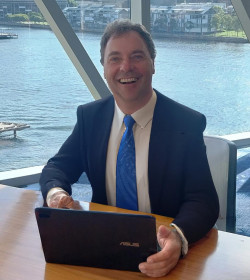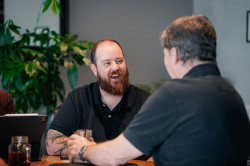Freelancing.HK-News 06/2025

Dear readers,
In this issue of our Freelancing.HK-News, I lightheartedly review a crowdfunded Freelancer’s comedy series.
Then we look at the cloud and why it is a good option for freelancers in the 21st century.
Also, it turns out a well known historian: Geoffrey Blainey, started out as a Freelancer way back in 1954!
Our fourth article is about how to build trust without being taken advantage of. Finally, our freelancer joke is about the similarities between freelancers and wanted criminals.
I hope you enjoy reading these articles and have a successful reminder of 2025!
Yours
Rainer Kurz
Freelancing as comedy?
The video series “Freelancers” is so funny that I’m chuckling about it hours later. This series was crowdfunded through Patreon and was so good that a second series was made! Fortunately, you have free access through YouTube.
It follows five twenty-somethings as they run a new business together and addresses problems that all businesses face in a light-hearted manner. For instance, the first episode deals with really, really needing insurance. In the second episode all five freelancers are cursed by a client who can’t pay.
Naturally, everything goes wrong, except that things going wrong may actually be going right? Oh well, this is fiction and a laugh. Both episodes show the importance of having enough capital to buy essentials and ride through the hard times. Now where did I put that Professional Indemnity and Public Liability quotation?
Head in the clouds
Dad asked me about ‘The Cloud’ as he kept hearing about it, but didn’t know what it was - apart from those fluffy white things we see in the sky.
I told him that he can think of the cloud as renting a car, rather than buying one.
If we don’t know how long we need a car for, we can hire it for an hour, a day, a week or longer and if we need more, we just hire more.
Alternatively, if we know we are going to use the car a lot, we buy it. Buying the car is equivalent to buying a server and setting it up to ‘serve’ up computing services like email and file sharing.
Both renting a car (cloud) and buying a car (server-client) give you the same result: Getting from A to B (computing services) but using the cloud means it´s someone else’s problem to set-up and manage, albeit at the cost of a regular fee.
When choosing a Cloud Service Provider (CSP), it is worthwhile to consider the Practice Guide for Cloud Computing Security.
Geoffrey Blainey, a pioneer in freelance writing
According to Allsop, R. (2020), Blainey travelled to Queenstown in Tasmania just before his 21st birthday and wrote the book The Peaks of Lyell (1954), as a freelance historian. Blainey was fortunate that he was recommended to Sir Walter Bassett of the Mount Lyell Mining and Railway Company to write the company history. Blainey was offered £16 per week as a freelancer, which was less than a labourer was paid, but bargained for a higher payment of £24 per week, to write the company’s history, the book being released over a year later.
Being one of just 36 books published in Australia in 1954, it was guaranteed to draw attention and is the only one still in print fifty years later. Blainey submitted his book for an MA and was awarded first-class honours, reversing the normal order of studying for a degree and then writing a book. As a freelancer, there was quite some time before he gained further work, but the success of his book meant other freelancing opportunities arose (pp. 41-49).
Blainey ended up as an academic, but returned to freelancing in the 1990s, writing six commissioned histories (Allsop, R (2020) p. 215). Blainey had found his freelancing
niche in writing Australian history and was now sought after for opinion pieces in Australian media (Allsop, R (2020) p. 219).
References: Allsop, R. (2020). Geoffrey Blainey : writer, historian, controversialist (1st ed.). Monash University Publishing.
How to secure your follow-up contract as a freelancer after the test phase - in just 4 weeks
The test phase: No contract. No safety net. No hidden costs. A freelancer is contacted by a potential client via Freelancing.hk. The conversation is going well, the chemistry is right. Then comes the sentence: “Let’s start with a small test task – before we move into the big collaboration.”
The freelancer hesitates. It sounds like mistrust. Like "prove it for free first." Like one of those jobs that ends nowhere. So he declines – politely but firmly. He never hears from that client again. The test phase was over before it even began.
Sound harsh? Yes. But situations like this happen every day. Because the rules of the game often remain unspoken during the test phase. Because many freelancers don´t know how to use them strategically – instead of feeling at the mercy of others.
But every test phase contains a real opportunity: to build trust, to demonstrate your position – and to almost guarantee follow-up business. This 4-week plan shows you how to do it. Without pushing. Without bragging. With clarity, strategy, and presence.
Week 1: How to build trust in the first days of the test phase
Those who only take on the execution are quickly overlooked. The first week determines whether you´re perceived as a person or merely a resource.
Introduce yourself actively. Not with a PDF attachment, but as a short message for a 15-minute conversation: “I would like to briefly introduce myself personally – 15 minutes, so that we can immediately clarify what a top result would be for you.”
Ask directly: "What would be a real hit for you?" This question makes it clear that you´re not thinking about yourself, but rather about the benefits for the customer. Clarify how communication will take place. Email? Weekly check-in? Clarifying this early on eliminates friction. And: Offer a short weekly status update – proactive, concise, and focused on impact.
Week 2: How to turn your work into a wow experience
Now´s your chance to make your first visible mark. Don´t just deliver, deliver something that will stick. For example, a smart workflow suggestion that saves time. Or a mini-graphic that simplifies complex information. Nothing fancy—but something that shows: "I´m thinking along!"
Explain not just what you´ve done—but why. And summarize your progress clearly—ideally: half a page with three bullet points. You don´t just control the project. You control how it´s perceived.
Week 3: From freelancer to sparring partner – this is how positioning works
Now it´s all about attitude. You don´t just want to react, you want to actively shape things. Analyze the project: What´s going well? Where is there potential? Be objective without being judgmental. Think along with others—not overthinking them.
Share learnings from other client projects: "X has proven successful in similar setups. Would that be feasible here?"
And then: Ask deep questions. Not small talk. But questions that make the customer fall silent for a moment – because you´re hitting on something.
Week 4: Strategically to the follow-up order – without pushing
Now it´s important to set the course. Naturally. Clearly. On an equal footing. Suggest a final meeting: “Let’s briefly combine a review and a look ahead – how did it go, what would be a sensible next step?”
Now it´s important to set the course. Naturally. Clearly. On an equal footing. Prepare a short presentation: 2-3 slides or 3 points for the call – what you´ve achieved, what´s still open, what you´re proposing. Be specific:
- Option A: 2 weeks of support for handover
- Option B: Continuation with a focus on [XY]
- Option C: Selective support for [XY]
Don´t sell. Offer. With attitude.
What remains – and what counts
Maybe you´re thinking, "That sounds good, but things are certainly different for my client." Or, "What if I give it my all and it still isn´t enough?" These thoughts aren´t wrong. They demonstrate that you care about your job. And that´s exactly the difference between someone who gets tested and someone who stays.
Look at what you now have in your hands:
✔️ A 4-week plan to give you guidance
✔️ Ways to become visible – without raising your voice
✔️ Tactics that build trust – not insecurity
You don´t have to set off fireworks. What matters is the quiet, consistent signal: "I´m here. I contribute. I add value." This isn´t a show. This is positioning.
And yes – it takes courage. The kind of courage that doesn´t shout, but simply stays. Stay visible. Stay real. And above all: Stay in the game. Because the moment your customer says, "Let´s move on", won´t feel like a fluke. It will feel like what it is – deserved.
Freelancer joke: 80% remote, 120% madness
In a kitchen, somewhere in Hong Kong, the wife of a freelancer is leafing through the local rag, frowns and calls toward the living room: "Honey, it says here that the Hong Kong Police Force is urgently looking for someone who systematically isolates people, puts them in windowless rooms for hours, gives them false hope, and slowly drives them mad."
The freelancer sips his double espresso, looks wearily up from his screen – five unread emails from the project manager, three open to-dos in Jira, a Teams call with 19 people where no one is speaking.
Then he says dryly: "Yeah, so... theoretically that would be exactly my thing. But I´m already booked to a large client as a Scrum Master with 80 percent remote."
If you have suggestions or want to subscribe to our newsletter, please leave your message here:
















